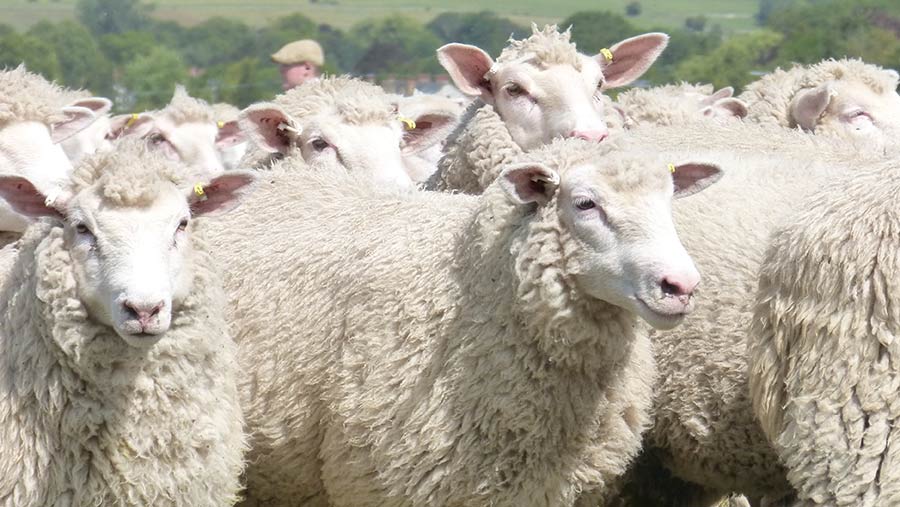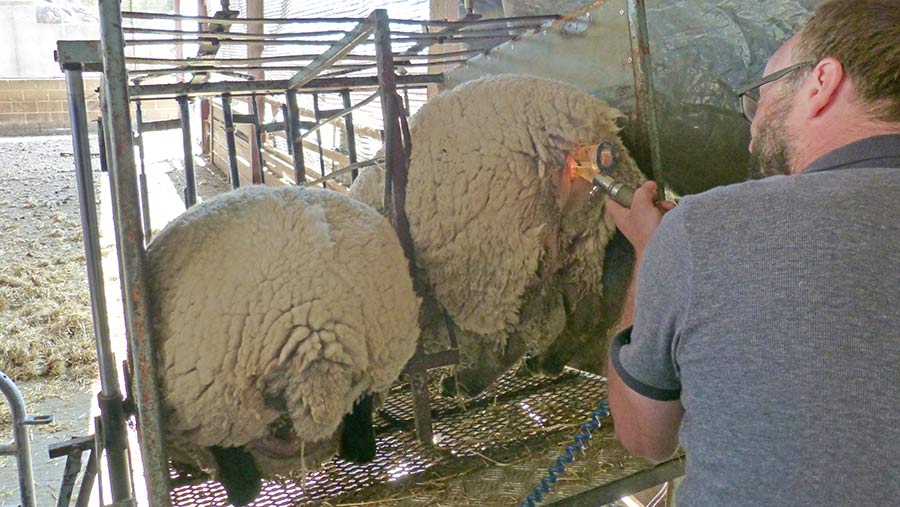How an Oxfordshire sheep unit sells 1.92 lambs per ewe

An early-lambing flock is achieving feed conversion rates of 2.5:1 and is selling 1.92 lambs per ewe. Michael Priestley visited Warborough Farm with the Nuffield Beef and Sheep Group to find out how.
Colostrum quality, stock skills and a milky and prolific crossbred ewe are allowing an Oxfordshire flock to sell 1.92 lambs per ewe in a housed finishing system.
The numbers
- 192% Proportion of lambs reared by shearlings and older sheep
- £89.94 Average price of lambs in 2019
- 2% Typical barren rate on mature sheep, while shearlings average 3%
Tony Good and head shepherd David Barber have devised a high-output system that finishes December-born lambs off concentrate feed to hit the Easter market.
All lambs at Warborough Farm, Letcombe Regis, spend their entire lives inside before being sent to deadweight processors from ten weeks of age.
By crossing Poll Dorset with Finnish Landrace after advice from Dr John Robinson at the University of Aberdeen in 1974, Mr Good developed the ‘Warborough’ breed (see box).
See also: Guide to breeding from ewe lambs
Farm facts
- 202ha (500ac) of grassland reverted from Barley when Mr Good bought the farm in 1971
- 2,000 Warborough ewes
- 153ha (380ac) in Higher Level Stewardship
- 48ha (120ac) in Entry Level Stewardship
- 14ha (35ac) of native woodland creation
- Predominantly producing U3H and R3H carcasses for ABP
- 20% annual flock replacement rate
And while Mr Good concedes the strategy is reliant on the Easter lamb trade and bought-in feed, the system has served the farm well over the last 40 years.
“If you were to start sheep farming today, this probably wouldn’t be the route you’d choose,” explains Mr Good.
“However, it’s allowed us to manage the rest of the farm environmentally and it produces young, tender meat that has compared favourably in taste tests with salt marsh lamb.”
Warborough breed
- A criss-cross breeding strategy started in the 1970s combining the conformation and early lambing of Poll Dorsets rams with the prolificacy of Finnish Landrace ewes.
- Chose first-cross homebred rams onto crossbred ewes in six family groups.
- Milk production was then maintained by crossing in British Milk Sheep in the 1980s.
- A focus back on Poll Dorsets has been used since to maintain the early lambing and growth of the flock.
- Currently the genetics is about 62.5% Poll Dorset, 12.5% Finnish Landrace and 25% British Milk Sheep
Breeding
Ewes are bred in July through a synchronised artificial insemination programme undertaken by Mr Barber, which typically achieves 80% conception at first service, meaning 1,000-1,200 ewes lamb in December in two weeks.

This is done to achieve a tight lambing window to hit early markets. They were rewarded with an average price of £105 for lambs sold in 2018.
Warborough’s breeding policy (see box below) uses homebred ‘Warborough’ tups, as well as top 1% Signet-recorded Suffolk and Charollais rams as terminal sires.
Any ewes that return from the AI process after one service are mated to terminal sires to lamb in January.
Warborough farm breeding policy
- Ewes in their third year with an average lambing percentage of 200% or more and one foot treatment or fewer are used to breed replacements.
- The remainder are served by terminal sires.
- Warborough rams are selected from ewes that average over 250% lambing and have no foot treatments.
- All breeding females are checked for conformation, structure, teeth and udders.
- Lameness, prolapses and prolificacy are all logged on Border Software through the Electronic ID system.
- Sheep are culled after their third case of foot rot.
- Six families are run on the farm. Ram lambs stay in the same family as their father and ewe lambs in the same family as their mother, rams are then moved on to the next family every 1-2 years to avoid inbreeding.
- The flock is fully scrapie resistant.
Lambing
Ewes are moved to individual pens as they lamb and are grouped after a maximum of 24 hours once lambs have been checked and had navals dipped twice in iodine and then moved to pens typically holding 66 ewes and 144 lambs.
Only potential replacements are tagged at birth and ram lambs remain entire.
No vaccinations or wormers are given to lambs and very little antibiotic is used. Some oral dosing is used later in the lambing shed on weaker looking lambs.
Cleanliness is ensured by topping up barley straw every day with a straw shredder. Barley straw is homegrown and from neighbouring arable farms.
Surplus colostrum
Ewe Colostrum is frozen in 2 litre plastic bottles and fed to lambs from larger litters as needed.
“Colostrum is vital to get lambs off to a good start and minimise antibiotics,” says Mr Barber.
Ewe lambs lamb at 170% and rear 164%, while shearlings lamb at 200% and mature sheep lamb at 220%, both with a mortality rate of about 7%.
Warborough lamb feed |
|
Starter pellets: 17.97% crude protein, 8.86% fibre, 4.26% fats and mineral additives including a plant extract and a yeast that work as a coccidiostat. This is fed from day seven until one-week post-weaning. |
|
Rearer pellets: 17.42% crude protein, 8.925 fibre, 4.2% fat and an acid buffer additive at 5kg/t plus vitamins. |
|
Finisher nut: 15.5% crude protein, 8.27% fibre, 4.51% fat and plus vitamins and minerals. Lambs are offered this for no more than two weeks prior to slaughter to avoid lambs becoming over fat. |
Lamb rearing
Lambs are creep-fed from seven days of age via a hopper and a trough topped up daily which can feed up to 200 lambs. All bought-in feed is made to bespoke requirements by GLW Feeds (see box).
Lambs are weaned at seven weeks old and then fed ad-lib pellets on the same double-sided hoppers, which are topped up every two days with about 75 lambs allocated per hopper. Barley straw bedding provides roughage.
Most lambs are usually sold in March and April, depending on Easter, with the last lambs sold in late May and early June at 20-21 weeks old.
Replacement ewe lambs are fed on concentrate the same way and introduced to grass in April and are bred in August.
This year’s farm records show a feed cost per lamb of £23.47, with 10 lambs finished per tonne of feed.
Ewe nutrition
December lambers are housed in pens of 60-100-head and fed a total-mixed-ration (TMR) through a Keenan mixer wagon in the last two weeks of gestation and through lactation.
The ration consists of clamp silage, with brewers’ grains (24% crude protein, 11.7ME) added according to silage analysis to achieve a ration of 17.5% CP, 100g of soya meal per ewe and minerals.
Silage is cut early to ensure high D-value, with around 44ha of first-cut and 32ha of second-cut, aiming for 10.5-11ME and 14% protein.
Ewe nutrition at Warborough |
|
Pre-housing |
|
|
Late gestation |
|
|
Lactating ewes |
|
|
Weaning |
|
